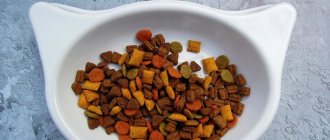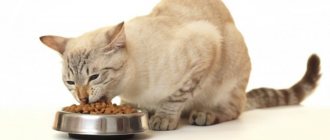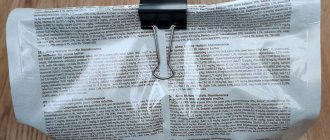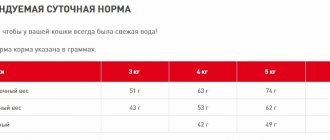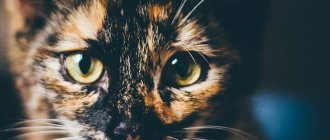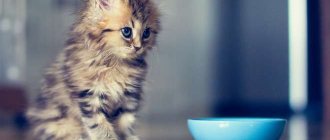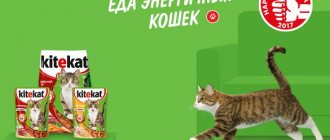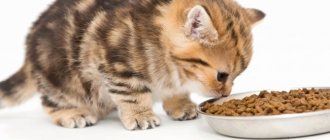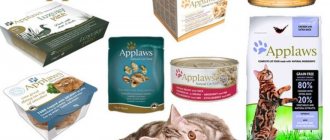- Kittens
- Physical activity
We are made of what we eat, and our furry flatmates are no exception. A real owner is simply obliged to take care of the correct menu for his pet: a balanced diet determines the appearance, vigor and health! It is necessary to feed cats and cats with a variety of dishes - then there is no imbalance or lack of individual biologically active elements. Animal, fish and bird proteins certainly alternate - just like in humans.
Ready-made food for cats allows you to simplify the process: the compressed grains contain all the components necessary for mustachioed and striped organisms. Using a convenient format does not come without subtleties. In order for the skin to shine, the eyes to glow, and a satisfied expression to remain on the faces, it is worth understanding the dosage and the hunger-satiety cycles.
Daily norm and product varieties
Keeping a pet is not a trivial matter, forcing you to understand the physiology and psychology of your charges.
Daily access to food
Having asked how much dry food to give cats per day for the miniature predators themselves, we will undoubtedly get the answer - more. But following the lead of gluttony is bad, despite sweet begging. Overeating is harmful and leads to the accumulation of excess pounds. It is better to immediately accustom him to the optimal calorie content. The criteria are clear and uniform for living beings. There are several parameters taken into account:
- size;
- age;
- hormonal background;
- mobility;
- presence of diseases;
- conditions.
Effect of feed classes
Food for snow leopards is divided into three types: economy, premium and super-premium. Inexpensive lunches are dominated by vegetable protein, while elite ones are made from fresh, non-frozen, natural semi-finished products.
In stores you can find authentic mixtures for small, old or sick people.
If, from prolonged use of a moisture-free consistency, the object of dietary planning becomes lethargic, the coat stops shining, and signs of obesity appear, the methodology is revised: fresh or canned food is added, and the volume of water drunk increases.
How to measure and weigh
It is easy to understand how many grams of food to prepare for a particular cat by checking the data presented below. Dividing the mass in a package of known weight into equal parts will help you measure. A measuring cup or kitchen scale will also work.
Moistened mass from spiders, cans, baskets
If the patient has problems with the chewing system or is recovering from an illness, a diet is prescribed. The crumbly and viscous substance is easier to chew and is absorbed faster. In general, cunning people who never refuse a snack prefer canned food - which comes in handy as a reward for decent behavior.
| Weight, kg | For 24 hours, g |
| 3 | 45 |
| 4 | 55 |
| 5 | 65 |
| 6 or more | 12 per 1 kg of weight |
Number of years, mobility and other nuances
The dimensions and tonnage of the discerning public vary. Males are heavier, denser and longer than females. Plus there is significant variation depending on the breed and due to individual variability. Large individuals eat more than small ones - a fact that is quite obvious.
Wet food
Wet food has approximately the same composition as dry food, plus it contains water. Suitable for pets who are prohibited from eating dry kibble for health reasons (urolithiasis, tartar), and for cats who are not inclined to drink a lot of liquid. A significant disadvantage is the high price.
Rules for feeding wet food:
- It can only be combined with dry food of the same line, following the dosages indicated on the packages.
- Do not store uneaten pellets at room temperature. They should be placed in a tightly sealed container and stored in the refrigerator.
How many times a day should I feed my cat wet food?
The general rule is 1-2 times a day. You can give your cat a portion of dry food in the morning and wet food in the evening. Kittens are fed 3-4 times a day.
Wet food intake per day
Depends on the specific product and the age of the pet. Super-premium food is the most nutritious, so less quantity is required per serving. Average indicators (grams of feed per day) are given in the table below.
| Weight, kg) | Daily requirement (g) | Kitten age (months) | Daily requirement (g) |
| 3 | 190-200 | 2-3 | 170-210 |
| 4 | 230-240 | 3-6 | 210-300 |
| 5 | 250-260 | 6-9 | 210-300 |
| 6 or more | 300 | 9-12 | 170-255 |
Table - How much pelleted food do cats need per day?
| Weight, kg | Approach (gram) | ||
| Normal | Dietary (weight loss) | Over 6 years old | |
| 2 | 40 | — | 30 |
| 3 | 45 | — | 30 |
| 4 | 60 | — | 40 |
| 5 | 75 | 60 | 60 |
| 6 | 80 | 60 | 60 |
| 8 | 90 | 75 | 90 |
| 10 | 120 | 80 | 120 |
Prevent malnutrition
How much food to give cats per day cannot be mathematically described in a table. The numbers don't paint a complete picture. It is important to monitor the well-being and weight of the animals. It is not recommended to exceed the dose. If there are persistent demands, the beggar is pleased by reducing the single portions.
Types of dry food for kittens
In order for your pet to receive all the nutrients important for its growth and development, you need to choose the right food. When purchasing, you should focus not only on the price, but also on the composition of the product. Dry food classes:
- Holistic foods are the most expensive foods that cannot always be found on sale in pet stores. This is the best commercial food for kittens 3 months old. Holistic products contain only natural ingredients. The source of protein and the main ingredient is natural meat. There are no components in this product category that can provoke an allergic reaction. The composition is perfectly balanced, all vitamins, macro- and microelements are present.
- Super-premium is not much inferior in quality and balance to holistic products, but costs an order of magnitude cheaper. This is also the best choice for 3 month old kittens.
- Premium is a good food with a high-quality composition, which includes natural ingredients. The source of useful elements is algae extracts. Before purchasing, you need to carefully study the composition, since there may be ingredients that cause allergic reactions in some animals that are intolerant to certain products.
- Economy. It is not recommended to use Whiskas, Friskas and other well-known cheap food to feed a kitten. There are exceptions among them - diets with a high-quality composition, without allergenic products, so before purchasing, be sure to carefully study the text on the packaging. Budget food often contains by-products instead of natural meat. To enhance the taste, food additives can be used, which often cause allergic reactions and indigestion.
When choosing a food category, the owner of a 3-month-old kitten should focus on his financial capabilities.
It is not recommended to change food as the kitten gets older from higher quality to budget food, as this can lead to health problems.
Daily regime
Feeding babies is a hassle: anxiety every four hours. Gradually the frequency is reduced. The ideal number for a mature and sedate audience is two.
When leaving the poor thing at home alone for a long time, it is ideal to count out food with a reserve (+ 10 - 15%) and leave a full bowl of water.
Kittens
The dry food limit for kittens under 2 months is from 25 to 40 grams in six doses. The next quarter, showing a claim to independence for naughty people - from 50 to 110 grams four times. During the period of intensive development for the next 3 months, the entire twenty-four-hour volume, from 65 to 120 grams, is divided into three parts.
Adults and young people
Fully formed March screamers are able to get by on two meals a day, corresponding to the above values.
The passing of years slows down the metabolic rate: intense in young people, and vice versa in older people. Meowing pensioners are given food more often, purchasing soft mixtures with a high proportion of fiber. Provisions based on dehydrated food for less massive kitchen regulars who are older and weigh up to 6 kg are reduced by 10 - 15%.
Individual approach
When deciding how many grams of dry food to give your kitten, remember that each animal is unique. Perhaps your pet will not be able to handle the entire recommended dose or, on the contrary, will beg for supplements. Here it is important to be guided not by emotions, but by objective data. If the baby is cheerful and active, gains weight normally, and has regular and well-formed stools, then he is eating normally and there is nothing to worry about. If you have any doubts about the correct feeding of your kitten, you should contact a veterinarian.
Increasing and decreasing dosage
How much dry food should be given to cats also depends on changing quantities that can be missed.
Physical activity
A pet can eat more abundantly if it does not lie on the couch in front of the TV for days on end: it can frolic in the room, it is played with and trained. Homebodies are in the same microclimate all year round, but for those who regularly walk and, say, live in a house with a yard, supplementation is essential in the cold season. In nature, natural hunters rest less, are constantly moving and will not be able to recover without training.
Age
A growing fidget does not save energy. Starting from three to four months, adolescents absorb the same amount of food as adults. When a family friend reaches seven years of age, adjustments are made and the edible quota is reduced.
Homeostasis after castration or sterilization
Losing the characteristic level of testosterone, males are prone to urolithiasis. Such individuals buy foods with a rich content of polysaccharides and legnin and reduced fat content. To prevent turning into an obese lazy person, the cat is given special attention: they play for a long time and are taken for a walk.
Pregnancy and lactation
In the second week of gestation, females increase the norm by 15%, and in the third - up to 50. The type of food remains the same, but with the addition:
- calcium;
- vitamins A, E and K;
- fiber.
The issue is resolved by switching to a specialized version from a familiar manufacturer. Well-known companies have a variety of product lines in their assortment and finding the right one is not difficult.
Before giving birth, animals usually refuse to eat. This is a natural and harmless reaction - there is no need to force it.
External factors
The diet is recommended for those who are injured, sick or under stress. They are given delicate, easily digestible food. When choosing a table in such cases, they try to purchase a gentle, lean substitute. The approach is also recommended when the person is overtired, after a long transportation or a powerful load on the musculoskeletal system.
Benefits and advantages of dry food
If the owner decides that his pet will be on a diet with industrial food, dry granules at 3 months are the ideal choice. This type of feeding has many advantages:
- At 3 months, the kitten’s body is actively developing . Accordingly, the full development of the animal and its health depend on how correctly the diet is prepared. Dry food is a product that contains all the necessary vitamins and minerals that simply cannot be obtained in the required quantities from natural products.
- Balanced diet . Feeding a kitten should be varied and correct. It should include carbohydrates, proteins and fats. It is difficult to independently calculate the balance of nutrients from natural products, but in industrial diets all elements are perfectly balanced, their concentrations are selected in accordance with the needs of the growing organism.
- Ease of use. If the kitten is on a natural diet, it needs to prepare food every day, since feeding from a common table is prohibited. This causes certain inconvenience for working people who are away from home for a long time. Dry granules can lie in a bowl for several days; they do not deteriorate and do not lose their benefits or taste.
However, you should remember - you need to choose only high-quality food for a kitten, and it can be expensive - this is the only drawback of industrial food.
What nutrients do cats need and why?
Protein
Cats have almost 3 times more need for protein than dogs; they really can’t live without it. In addition to the fact that mustachioed pets have an exceptional need for a constant supply of essential amino acids to the body, there is also a difference in protein metabolism. If there is a lack of protein in food, the liver will begin to consume it from the cat’s body, depleting it. In dogs, the speed and level of its decomposition reflexively decreases, due to which its preservation and need increase.
Such a high need is explained by the body’s constant need for essential amino acids - leucine, threonine, arginine, lysine, phenylalanine, etc. These substances are needed to maintain the normal condition of the coat, as well as for a sufficient amount of feline - a unique substance excreted in cats in the urine. There is especially a lot of it in cats - it is this that gives such a pungent smell to the urine of adult sexually mature individuals.
Another very important essential acid for Murok and Murzikov is taurine. It is synthesized in the body of dogs, but not in cats. This amino acid is absent in protein, but is found in muscle fibers of animal origin, i.e. meat is a pure protein product. Lack of dietary intake leads to disruption of the reproductive system, cardiovascular system and destruction of the retina. There are even special taurine deficiency syndromes associated specifically with disruption of the above-mentioned organs and systems.
Protein must be supplied to cats' bodies constantly! Source of protein for cats: meat, fish, dairy products. Source of taurine: meat and fish (mostly in turkey and raw tuna).
Fats
Not only the energy value of the food depends on this nutrient, but also its palatability for animals (of course, vegetable oil for a cat will be less attractive in smell and taste). In addition to energy, fats in the body perform two more very important functions - they dissolve fat-soluble vitamins into an easily digestible state and are a source of essential fatty acids. A cat's daily diet should contain at least 15% fat, and if it is a kitten, then all 20%.
Source: animal and vegetable fats.
Carbohydrates
They consist of difficult-to-digest (fiber) and easily-digestible (starch and sugar). Fiber is needed for physiologically normal fecal formation. With enough of it - as much as needed - the cat will never have constipation or diarrhea due to nutrition. An excess of easily digestible carbohydrates leads to obesity and can trigger the development of diabetes.
Cats should receive 0.32 g of fiber and no more than 2.7 g of easily digestible carbohydrates per kilogram of weight per day.
Source of carbohydrates for cats: cereals (buckwheat, rice), bran, honey. The fiber comes from the same place plus vegetables.
Minerals and vitamins
Like any living organism, cats also need vitamins and minerals. The need for these substances can be met with the help of special vitamin complexes and feed additives. There are several nuances: cats do not need vitamin C, because... They produce it in the liver, but they need direct vitamin A, not beta-carotene, because the transformation of one substance into another does not occur in their body. This means that you should not feed Murka citrus fruits during a cold, and carrots in the diet should be replaced with liver.
Author:
Grinchuk Ekaterina Andreevna veterinarian
Should treats and other food additives be included in a cat’s daily diet?
Often, responsible owners think about how to include treats and vitamins in their diet without harming their pet. Here you should rely on the following rules:
- Issues of vitaminization are resolved exclusively with a specialist.
- You can pamper a cat, but without fanaticism. Otherwise, the treat can turn into a full-fledged diet, and this is not very good. For a simple solution, you can resort to the banal cultivation of grass for cats. And it’s not troublesome, and you won’t overeat, and you won’t get hypervitaminosis.
The herb will help remove hairballs from the digestive tract and provide the cat with essential vitamins without the risk of overdose.
- When receiving high-quality food, the cat will definitely not need an additional vitamin complex, unless this is a highly specialized prescription made by a specialist.
Nutrition of adults
Daily feeding standards for dry food involve feeding adult cats twice a day. Some owners allow their pets to eat more often. However, an obese animal should not be allowed unimpeded access. Remember: excess weight provokes serious disruptions in the functioning of the body, leading to diseases of the thyroid gland and hypothalamus. On average, a mature individual requires 80-120 grams. daily.
As for cats, 180-210 kcal is enough for them. The formula will help you calculate the amount of dry food: 30 - 60 kcal multiplied by weight. So, an adult cat weighing 5 kilograms needs 150 - 300 grams daily.
Sometimes cats refuse to eat for a long time. The situation can be misleading; the owner’s first thought is: “I’m sick.” Refusal to eat for more than 48 hours indicates not only illness, but also stress, for example, moving to a new place of residence. A dirty bowl and bad-smelling food are common reasons for refusing to eat. Keep the bowl and area clean.
The characteristics of the breed impose restrictions on the daily amount of food. Maine Coon, Norwegian Forest, Cornish Rex are naturally prone to gaining excess body weight. It makes sense to switch purebred pets to a special low-calorie food. A cat’s daily diet depends on several factors: health status, breed characteristics, lifestyle.
Why can't you feed your cat dog food?
The only and most important reason for this is different metabolism and the need for certain energy substances. You need to clearly understand the difference between the food and diet of a cat and a dog.
What is the difference between cat and dog food?
- Dog food contains very little protein because... these pets do not have an urgent need for it. Cats need protein constantly and in large quantities. Dog foods contain more plant components and grains - things that cats have difficulty digesting or cannot digest at all.
- Cat food contains vitamin A, and dog food contains beta-carotene, from which vitamin A is synthesized by the body itself. If you feed your cat food that is not your own, then over time vitamin A deficiency may develop and vision problems may appear, hair will begin to fall out and the skin will peel/itch.
- Dog food does not contain taurine, because... the liver of these animals synthesizes it itself in the required quantities. In cats, the liver does not do this, and the need for taurine is enormous. Thanks to this amino acid, fats are processed, blood clotting factors work normally, and the nervous system, immune and cardiovascular systems function without disruption. Cat food contains much larger quantities of meat components.
Feeding any type of animal with “not your own” food can lead to a lack or excess of certain nutrients, which, in turn, will definitely cause health problems over time!
Key points in feeding kittens
The main question: is it possible to feed a kitten dry food? You can make it the main dish of your baby’s menu from the age of two months, without mixing it with natural products, avoiding unnecessary stress on the digestive organs.
How much to give daily?
- For a kitten of three to six months, it is recommended to pour 50 - 110 grams, feed 4 times;
- a six-month-old baby will need 200 - 250 grams (period of intensive growth), feed 2 - 3 times;
- 200 grams is enough for a one-year-old fluffy.
Focus on the composition of the product. High-quality dry cat food is balanced, contains the necessary vitamins and minerals, and ensures proper development. If you give vitamin supplements unnecessarily (unless prescribed by a veterinarian), you risk provoking the development of the disease.
Take care of the feeding area; ideally it is:
- quiet, without the presence of strangers (if there are a lot of pets, make sure you have an individual bowl);
- clean.
An important point is to ensure access to clean drinking water: dry food does not contain liquid, drinking will help the kitten avoid dehydration.
Nutrition for older cats
The norms for feeding dry food to older vary significantly. This is due to a decrease in the activity of animals (sleep time increases, periods of activity decrease, fewer calories are consumed). Much attention is paid to nutrition: food affects the health and quality of life of an elderly family pet. The choice should be made on special foods that are rich in protein and low in carbohydrates, which increase the risk of obesity.
Daily nutritional requirements for elderly pets
The daily serving of cat treats depends on the brand of dry food. Normally, it is 5-7% of body weight. However, the cat will need more food if the owner purchases economy-class food, since the composition of the food differs in the content of cellulose, animal waste, and is low in calories.
High-quality food is more expensive, but has the advantage that you can give your pet small portions. Food containing vitamins and animal fats helps support the immune, urinary, and cardiovascular systems of an elderly cat. He advises you to pay attention to the following brands of food: Purina, Royal Canin, 1st choice.
